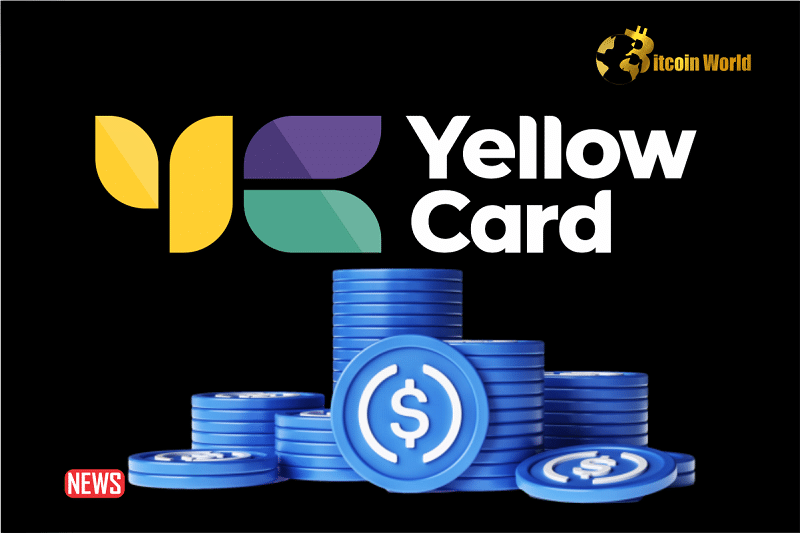- Yellow Card partners with Stellar for USDC integration, facilitating faster and cheaper transactions in Africa’s digital economy
- Partnership targets African banking hurdles, offering easier access to digital assets and financial services
- Initiative merges traditional finance with blockchain, boosting financial inclusion in Africa via incentivized USDC transfers on Stellar
An African stablecoin on/off-ramp platform, Yellow Card, has announced its partnership with the Stellar network to introduce USDC integration.
This development holds significant implications for global payments and digital asset adoption, particularly in the context of Africa’s developing digital economy.
Yellow Card is making a new move by bringing the stablecoin USDC to the Stellar network.
This announcement is sparking excitement because it opens up a lot of potential for easier global payments and more people using digital assets.
Yellow Card’s integration of USDC on the Stellar network allows its users to conduct transactions with greater speed and lower fees, thanks to Stellar’s efficient blockchain infrastructure.
USDC, as a stablecoin pegged to the US dollar, provides stability in value while leveraging the benefits of blockchain technology for instant settlement and borderless transactions.
Yellow Card And Stellar Network Drive Financial Equality
The partnership signifies a strategic alignment between Yellow Card and Stellar to address the challenges of traditional banking infrastructure in Africa, such as high remittance costs and limited access to financial services.
By providing individuals and businesses with access to USDC via the Stellar network, Yellow Card aims to democratize financial access and empower economic growth across the continent.
Moreover, Yellow Card’s collaboration with Stellar follows closely on the heels of its partnership with Coinbase, further expanding its reach and product offerings across Africa.
The synergies between these partnerships strengthen the impact of USDC integration, potentially reaching millions of users and businesses in the region.
As part of its efforts to promote adoption, Yellow Card has introduced an incentive program offering rewards to users who transfer USDC stablecoins via the Stellar network.
This initiative not only encourages usage but also demonstrates Yellow Card’s commitment to driving user engagement and awareness of digital asset solutions.
In short, the integration of USDC on the Stellar network by Yellow Card represents a significant step towards advancing financial inclusion and innovation in Africa and beyond.
By bridging the gap between traditional finance and blockchain technology, Yellow Card and Stellar are paving the way for a more accessible, efficient, and inclusive financial ecosystem in the region.
Now, let’s Crystal Clear the basic terms of this article. This will profoundly connect you with the important and main factors of this story.
Helping you to understand digital finance in a better way. This explanation clears your primary doubts about what exactly it is and how it works.
In the rapidly growing world of digital finance, terms like “on/off-ramp,” “USDC (USD Coin),” and “Stellar network” are becoming increasingly widespread.
Understanding these concepts is vital for understanding the significance of Yellow Card’s latest announcement regarding its integration of USDC on the Stellar network.
See Also: OpenAI And Microsoft Join Forces To Prevent Cyberattacks From Malicious Actors
Connection Between Stellar Network And Yellow Card’s Platform
Yellow Card’s decision to introduce USDC on the Stellar network represents a strategic alignment aimed at enhancing the accessibility and efficiency of digital financial services, particularly in regions like Africa.
By leveraging the Stellar network’s capabilities, Yellow Card can offer its users lightning-fast transfer speeds and lower transaction fees compared to traditional banking systems.
This integration opens up new avenues for individuals and businesses to access stable digital assets like USDC, empowering them with greater financial inclusion and opportunities for economic growth.
Furthermore, Yellow Card’s partnership with the Stellar network extends beyond technical integration.
It signifies a shared vision of leveraging blockchain technology to drive positive change in the global payments landscape.
Through this collaboration, Yellow Card and Stellar are pioneering innovative solutions to address the challenges of traditional finance, ultimately fostering greater financial empowerment and inclusivity worldwide.
Conclusion
Yellow Card, a licensed stablecoin on/off-ramp platform, has announced plans to introduce USDC (USD Coin) on the Stellar network.
This move signifies a significant development within the cryptocurrency ecosystem, as it expands the utility of USDC while leveraging the capabilities of the Stellar network.
Yellow Card’s integration of USDC on the Stellar network represents a significant step towards advancing financial access and innovation.
By bridging the worlds of traditional finance and blockchain technology, Yellow Card is helping to build a more inclusive and resilient financial ecosystem, one transaction at a time.
#Binance #WRITE2EARN













